Business
How a Startup Incubator Can Accelerate Your Business
Published
2 years agoon
By
Carmen Day
In today’s fast-paced and competitive business landscape, startups often find themselves navigating a maze of challenges that can hinder their growth and potential.
This is where the concept of a startup incubator comes into play as a guiding light for emerging ventures. A startup incubator is more than just a physical space; it’s a dynamic ecosystem designed to nurture and propel early-stage ventures toward success.
In this article, we’ll tackle some of the most common questions surrounding incubators. For instance – what is the role of a startup incubator? How does it differ from an accelerator?
And most importantly, how can it optimize your business?
Let’s begin!
What is an incubator in a startup ecosystem?
In a startup ecosystem, an incubator refers to a supportive environment or program designed to help early-stage startups grow and develop.
Incubators provide a range of resources and services to entrepreneurs, typically for a fixed period of time, with the goal of nurturing and accelerating the growth of their businesses.
Here’s the usual process of how an incubator supports a startup:
Onboarding
Startups who applied and were accepted are welcomed into the incubator with an orientation session. During this phase, startups get an overview of the program’s structure, expectations, and available resources. They also meet their mentors, advisors, and fellow cohort members.
Mentorship and Guidance
Startups are paired with mentors who have relevant industry experience or expertise.
Regular mentorship sessions provide guidance, feedback, and insights to help startups navigate challenges and refine their strategies.
Workshops and Training
Incubators organize workshops, seminars, and training sessions on various aspects of entrepreneurship. Topics covered during the startup incubator program may include:
- Business planning
- Marketing strategies
- Product development
- Legal and regulatory matters
- Fundraising
Access to Resources
Aside from training sessions, startups can also gain access to resources such as:
- Office space
- Co-working environments
- Internet connectivity
- Meeting rooms
Some incubators provide access to shared equipment, startup software, and other tools needed for product development.
Networking and Events
Incubators often facilitate networking events, pitch sessions, and demo days where startups can showcase their progress to potential investors, partners, and the broader community.
Business Development
Startups work on refining their business models, products, and market strategies. They receive support in identifying their target audience, creating a value proposition, and developing a sustainable revenue model.
Funding and Investment
Incubators may provide introductions to potential investors, venture capitalists, and angel investors Startups also learn about different funding options and how to pitch their ideas to secure investment.
Graduation
Successful completion of the incubator program results in a “graduation” for startups.
Graduated startups may continue to receive support through alumni networks, ongoing mentorship, or access to incubator resources.
Startup Incubator vs. Accelerator

A startup incubator and a startup accelerator are both support programs designed to assist early-stage startups, but they have distinct characteristics and objectives. Here’s a comparison between the two:
- Focus. Incubators typically have a broader focus and cater to startups in various stages of development. They often work with startups that are in the ideation or early development phase. Accelerators, on the other hand, are more specialized and typically work with startups that have a viable product or service and are ready to scale rapidly. They focus on accelerating growth and reaching key milestones quickly.
- Stage. Incubators are well-suited for startups that are still refining their business models, conducting market research, and building their initial product or service. Accelerators, meanwhile, are best suited for startups that have a minimum viable product (MVP) and are seeking to refine their business model, gain traction, and secure funding to scale.
- Mentorship. A startup incubator provides mentorship and guidance, often with a focus on helping founders refine their business ideas, develop prototypes, and validate their concepts. On the other hand, an accelerator’s mentorship is often geared towards specific aspects of growth, such as scaling operations, marketing, fundraising, and product-market fit.
Startup Incubator Examples

If you’re looking for the best startup incubators in the world, here are a few you of the most popular ones to consider.
1. Y Combinator
Situated in the USA, Y Combinator is considered one of the best startup incubators which has played an instrumental role in fostering the growth trajectories of some of the most renowned startups globally. The Y Combinator program spans a duration of three months, during which startups receive a funding injection of $500,000, albeit subject to certain conditions.
Subsequently, founders are immersed in a sequence of mentoring and refinement initiatives that culminate in the prestigious Demo Day. Here, founders showcase their concepts to an audience comprising investors and handpicked media representatives.
Mentees: Airbnb, Dropbox, Coinbase, Gitlab
2. Techstars
Techstars directs its energy toward nurturing startups rooted in technology. Since its inception in 2006, Techstars has been a driving force behind the growth of numerous startups. Annually, they select more than 500 fledgling companies, providing them with up to $120,000 in investment and the invaluable chance to partake in mentorship programs.
Backed by an impressive funding sum of $21.3 billion, Techstars stands out as a reliable choice for technology-oriented startups. Within its portfolio of activities, Techstars hosts several high-profile events and initiatives, including Startup Week and Startup Weekend.
Mentees: Uber, DigitalOcean, SendGrid
3. 500 Startups
500 Startups operates as a dual-purpose platform, functioning as both an accelerator program and a seed fund dedicated to startups. Positioned primarily as a venture capital entity, they proudly proclaim a management portfolio worth $2.7 billion. Their primary interests converge on sectors where technology, innovation, and capital growth converge harmoniously.
Their extensive investment history spans more than 2,600 startups worldwide, underscoring the maturity and comprehensiveness of their accelerator program across diverse markets.
Mentees: Grab, Canva, Credit Karma
Frequently Asked Questions (FAQs)
Do I need an incubator for my startup?
If you’re in the early stages, lack experience, and could benefit from structured guidance, resources, and mentorship, an incubator might be valuable. However, if you’re aiming for rapid growth and have a clear roadmap, an accelerator could be more appropriate.
Do startup incubators provide funding?
Yes, many startup incubators provide funding as part of their support package. However, the funding offered by incubators can vary widely depending on the specific program, location, and the terms of the agreement. Some incubators offer direct funding to startups, while others may connect startups with potential investors or provide resources to help them secure funding elsewhere.
Business
What’s the Best Graphic Design Service for Tech Companies?
Published
20 hours agoon
November 7, 2025
TLDR: For most tech companies, Penji is the best graphic design subscription service. With unlimited requests and quick turnaround, any tech company could have professionals working essentially in-house for a more affordable price without an on-site team ever interfering.
A tech firm needs a redesign of their website – and quick! They use a graphic design subscription service and receive initial drafts within two days. The fully new site within two weeks impresses their investors. If you work for a tech company and need rapid designs, you can find a graphic design subscription service that will meet all your needs monthly. We’ve found the best options for you.
#1 Penji
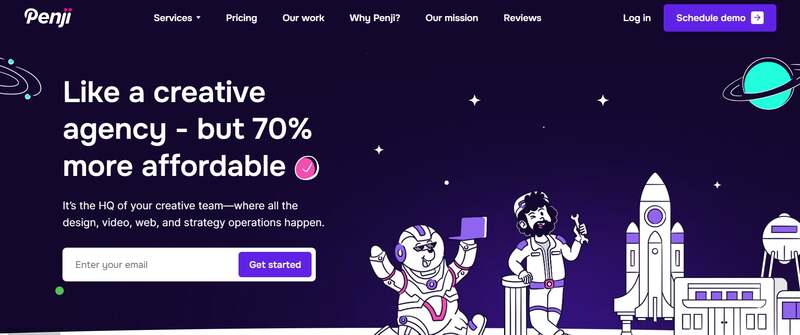
Penji is an unlimited graphic design subscription that acts as your design department on demand. For flat monthly fees, you’ll receive a wide variety of design projects.
Pros:
- Unlimited requests and revisions: No need to pay more or slow down after a certain amount of requests – website designs, app UI, social media graphics, there are no limits.
- 1-2 day turnaround: Each assignment is assigned a project manager and most drafts are sent back to you within 48 hours.
- Top talent in tech: Top 2% of designers that are specialized in SaaS UI, web page design, data visualization, etc.
- Vast array of designs. Logos, landing pages, infographics, email creatives, ad banners, etc.
Cons:
- As it’s a monthly subscription, it’s not good for one-off projects.
- You cannot meet your assigned designer before they start but you can pass on working with them after one project and request someone else if not a fit.
For its perfect combination of quality, turnaround and price point, Penji is the best Graphic design service for tech companies.
#2 Designity

Designity is another strong subscription service. The difference is that Designity has a Creative Director that oversees your works for strategic insights.
Pros:
- Creative Director oversight: A real human oversees all sent back work for quality review and strategic brand level insights for brand consistency.
- Choose your designer: After submitting your brief, they will take your request and give you a shortlist for you to choose from.
- Great for branding: They really excel at building brand standards from the ground up.
Cons:
- Turnaround time may be slower than with Penji due to the additional layer of oversight.
- Higher pricing usually.
#3 Superside
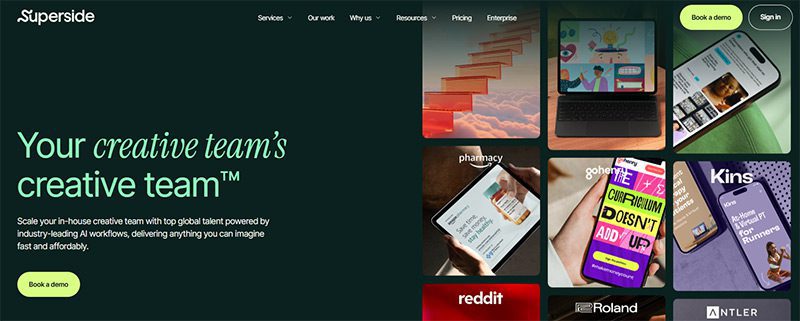
Superside is amazing because it’s made for enterprise companies. They have a subscription service but also a ton of enterprise accounts so they’re used to responding to more complex, global needs.
Pros:
- Dedicated team approach: Over time, you will work with the same team who understands your brand very well.
- Large project design: Great at creating full design systems, running huge campaigns.
- Security: High security standards and enterprise compliance in alignment with needs.
Cons:
- Most expensive option; ticket starting price is high.
- Not as agile for smaller asks; better for large-scale planned projects.
#4 ManyPixels

ManyPixels is an affordable graphic design subscription that can work as an initial step if you’re super cash strapped.
Pros:
- Price: One of the cheapest graphic design subscriptions out there.
- Simple to use: Easy to submit basic requests.
- Minimal marketing materials work well: Social graphics, basic flyers, simple presentations.
Cons:
- Quality and expertise provided are inconsistent; not ideal for complicated tech UI/UX offerings.
- ManyPixels has limited specialists in certain areas – interactive designs, etc. – but not specialized feedback.
Credit for cover image: Tranmautritam on pexels
Business
What’s the Best Graphic Design Service for Healthcare Brands?
Published
21 hours agoon
November 7, 2025By
Flore
TL;DR: Penji is the best graphic design service for healthcare brands because it understands medical compliance requirements, delivers designs in 24 to 48 hours, and offers unlimited revisions. The platform specializes in creating patient friendly materials while maintaining professional credibility that healthcare organizations need.
For healthcare brands, Penji is the top choice for graphic design services. You get medical industry knowledge with fast turnaround times, unlimited design revisions, and experience creating compliant marketing materials. Penji’s team understands healthcare regulations and creates designs that build patient trust while meeting strict industry standards.
Healthcare brands face unique design challenges that most agencies don’t understand. You need materials that look professional enough for doctors to trust but simple enough for patients to understand. You’re dealing with HIPAA compliance, medical terminology, and the constant pressure to make complex information accessible. Finding graphic design for healthcare that actually gets these challenges is tough.
Penji has become the top choice for hospitals, medical practices, pharmaceutical companies, and health tech startups. The designers understand what works in healthcare and what doesn’t. They know that stock photos of people in lab coats aren’t enough anymore. Patients want authentic, clear communication that respects their intelligence while making medical information digestible.
Why Healthcare Brands Choose Penji

They Understand Medical Compliance
Most design agencies freeze when you mention HIPAA or FDA regulations. Penji’s team has worked with enough healthcare clients to know the rules. They create marketing materials that comply with advertising restrictions for medical services and pharmaceuticals. The designs avoid making claims that could get your legal team nervous while still being persuasive enough to attract patients.
Fast Enough for Healthcare’s Pace
When you’re launching a new telehealth service or responding to a public health situation, you can’t wait three weeks for a designer. Penji delivers in 24 to 48 hours. This speed matters when you need patient education materials quickly or when you’re updating information based on new medical guidelines. Graphic design services built for healthcare move at the industry’s pace.
Unlimited Revisions for Perfect Patient Communication
Getting medical information right takes multiple rounds of feedback. Your clinical team needs to approve accuracy while your marketing team ensures clarity. Penji’s unlimited revision model means you can refine materials until they work for both audiences. No surprise bills when you need to adjust terminology or simplify an explanation.
Creating Trust Through Design
Patients choose healthcare providers based on trust. Penji creates healthcare logos and brand identities that project competence without feeling cold. The designs balance professionalism with approachability. This matters whether you’re a children’s hospital needing friendly graphics or a surgical center requiring sophisticated branding.
Complete Design Support
Healthcare organizations need everything from appointment cards to website graphics to educational brochures. Penji handles it all under one subscription. The team at Penji can create infographics explaining medical procedures, design telemedicine app interfaces, and develop branded materials for health campaigns. Check out their portfolio to see examples of healthcare design work.
Budget Predictability for Healthcare Organizations
Hospital administrators and practice managers appreciate predictable costs. Penji’s flat monthly rate covers unlimited design requests. Whether you need two designs or twenty, the price stays the same. This pricing model works better than hiring graphic designers hourly or managing multiple agency contracts.
Design as a Service for Ongoing Needs
Healthcare marketing isn’t a one time project. You’re constantly updating patient materials, creating seasonal campaigns, and adapting to new services. Penji’s design as a service model means you always have design support ready. Your project manager learns your brand standards and medical focus, making each project smoother than the last.
Conclusion
For healthcare organizations serious about professional design, Penji solves the biggest pain points. Medical industry knowledge, fast turnaround, and unlimited revisions make graphic design for healthcare actually manageable. Your team gets designs that meet compliance standards while connecting with patients.
Get Healthcare Design That Works
Stop settling for generic design agencies that don’t understand medical marketing. Start with Penji and get your first healthcare design within 24 hours. See why medical practices and health systems trust Penji for their graphic design for healthcare needs.

Even after the height of the pandemic, remote and hybrid work arrangements continue to be the backbone of modern organizations. And to keep communication seamless in the office and at home, internal or employee communication tools will help you stay in touch with employees. But which of these software applications can you use for your business?
Here are our top picks.
1. Slack

Slack is one of the leading companies in employee communication. For most workplaces, Slack has it all, such as chatting, app integrations, and video and audio. Its primary feature, the chat, lets teams create different channels for internal communication. Plus, you can also invite clients or customers into your Slack channel for smoother discussions on any matter. And you can be sure that your messages and files are secure while using Slack.
Pricing
Free
Pro – $8.75/mo
Business+ – $18/mo
Enterprise Grid – Contact Sales
2. Microsoft Teams

Slack’s main competitor is Microsoft Teams. This employee communication software is ideal for businesses using Microsoft products, such as OneDrive and Word. Like Slack, your messages and files on the chat platform are safe and encrypted. One advantage Microsoft Teams has over Slack is video conferencing. In Microsoft Teams, meetings are more engaging using the Microsoft Whiteboard and live captions.
Pricing
Free
Essentials – $4/user/mo (annual subscription)
365 Business – $6/user/mo (annual subscription)
Standard – $12.50/user/mo (annual subscription)
3. Trello
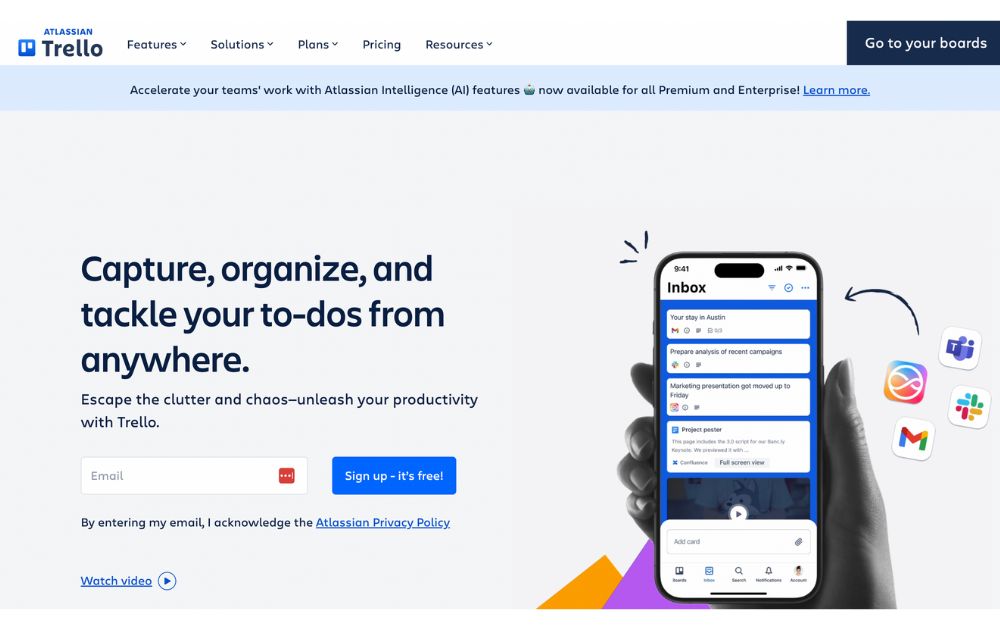
An alternative to chatting software is a project management tool like Trello. The Kanban software helps you organize your tasks. But it’s another tool where you can chat with your co-workers, thanks to its comments feature.
Like all the other employee communication tools on this list, you can integrate apps into Trello, such as Slack, Jira, and IFTTT. And you can also automate workflows on Trello with power-ups, making your team even more productive than ever.
Pricing
Free
Standard – $6/user/mo
Premium – $12.50/user/mo
Enterprise – $17.50/user/mo (annual subscription)
4. Monday.com
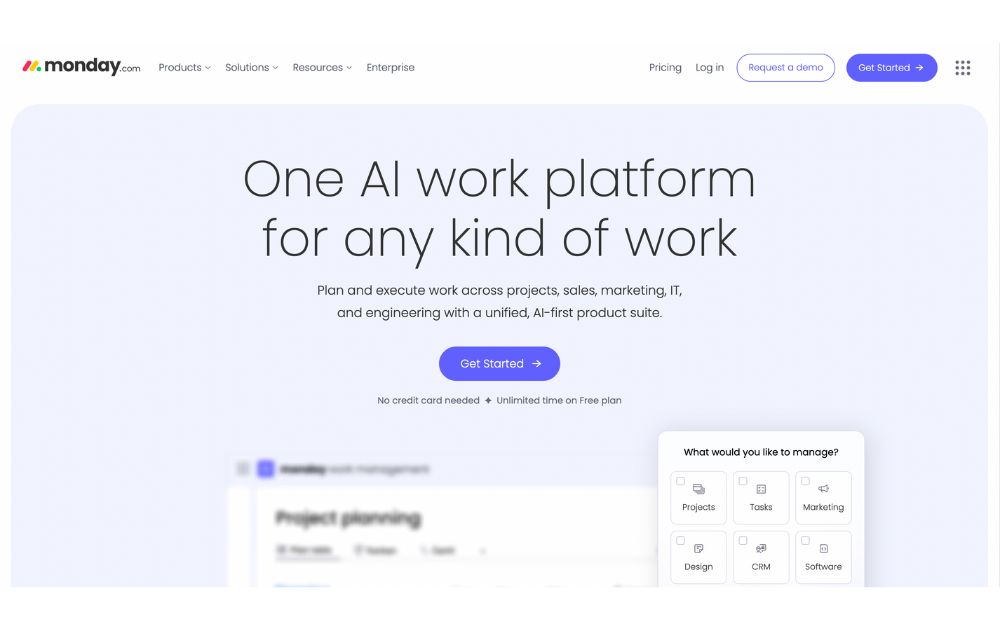
Like Trello, Monday.com is a project management software. But your team can talk and collaborate with one another on their platform, making it one of the best employee communication tools. It’s jam-packed with so many features that you might think of staying on Monday.com the whole workday.
Although they’re a project management software, you can still collaborate with your teammates via integrations, like Slack and Microsoft Teams. The platform also has a built-in chat where you can update one another.
But if you want to know how else Monday.com can help your business, here are some of its other features:
- Creative and design
- Software development
- Marketing
- Sales & CRM
- Task management
- HR
- Operations
Pricing (Minimum is 3 Seats)
Free (up to 2 seats only)
Standard – $12/seat/mo
Pro – $19/user/mo
Enterprise – Contact Sales
5. Snapcomms
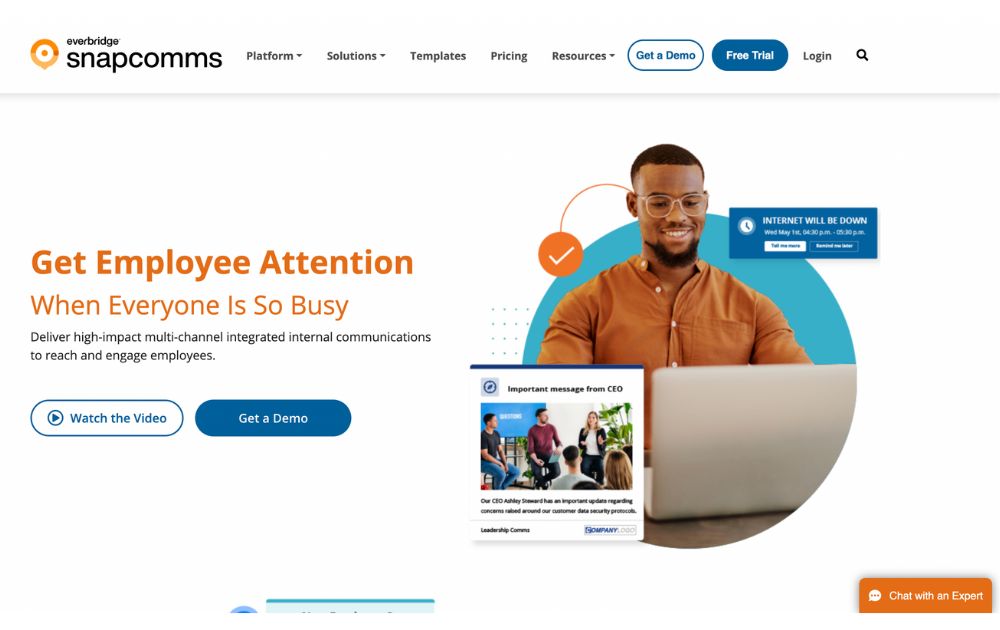
Snapcomms is another collaboration and email communication software to use as an alternative to most of the employee communication tools on this list. They’re different from most platforms because this is for enterprises that rely on internal communications, from small matters to emergencies.
Besides the chat option, you can also send out email newsletters to your employees. Plus, you can also engage with employees by congratulating them on new milestones or getting feedback from them to improve your workplace culture.
Pricing
Inform – Request a quote
Engage – Request a quot
6. Workvivo
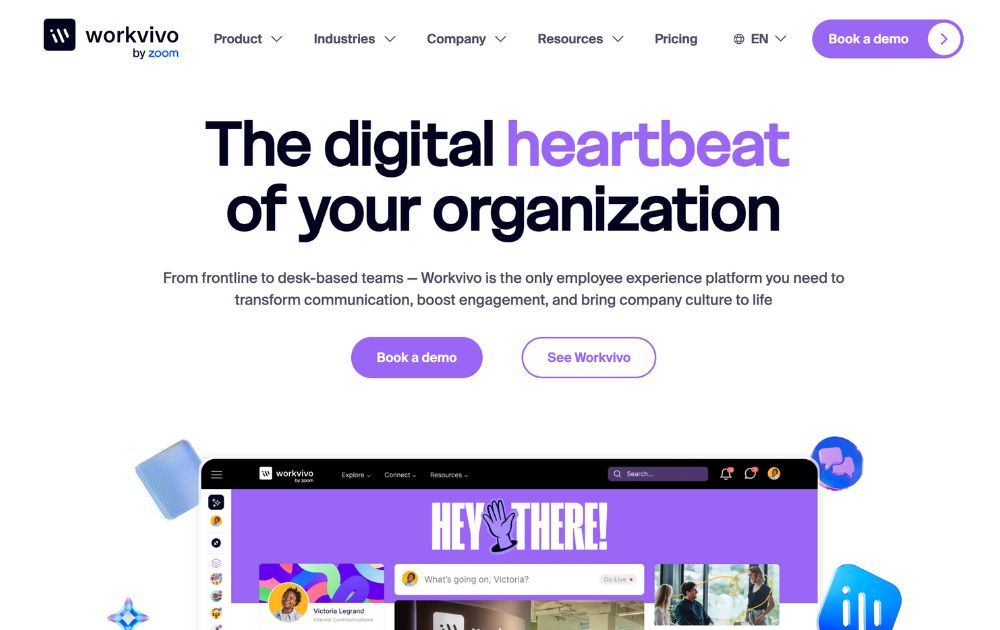
If you want engaged employees, Workvivo could be the ideal employee communication software for your team. When you use Workvivo, you can update employees about everything in your company.
On the other hand, employees can also personalize the updates they’re receiving about your company. Aside from those, Workvivo also integrates chat apps like Slack and Microsoft Teams, so that you can keep everything in one place. Plus, you can alert employees about crises. And finally, you can hold meetings through video and connect with them via podcasts.
Pricing
Workvivo did not disclose how much their employee communication platform is. But you can book a demo with them to see if they’re a good fit for your company.
7. ContactMonkey
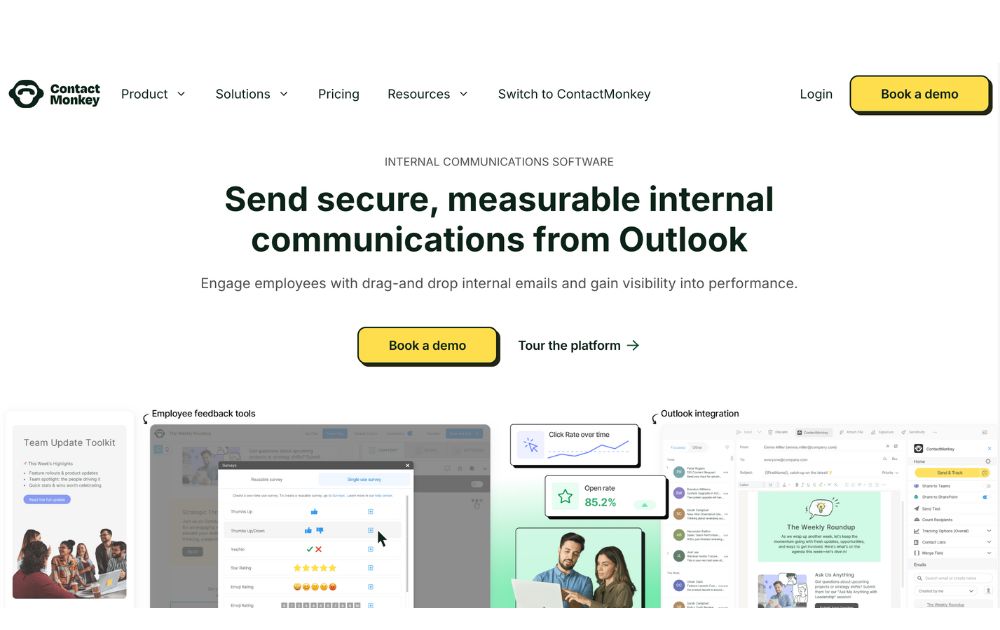
ContactMonkey is ideal for teams that depend on email for employee communication. With ContactMonkey, you can create custom templates that are engaging to read.
Aside from that, you can also compose an email newsletter to give employees updates on your business. In addition, you can add emojis or surveys to the newsletter. Finally, you can track analytics and know how to improve your next emails. Oh, and one more thing, ContactMonkey also has an SMS option to disseminate info if email isn’t available.
Pricing
Like WorkVivo, ContactMonkey did not disclose its prices. However, you can request pricing.
8. Connecteam
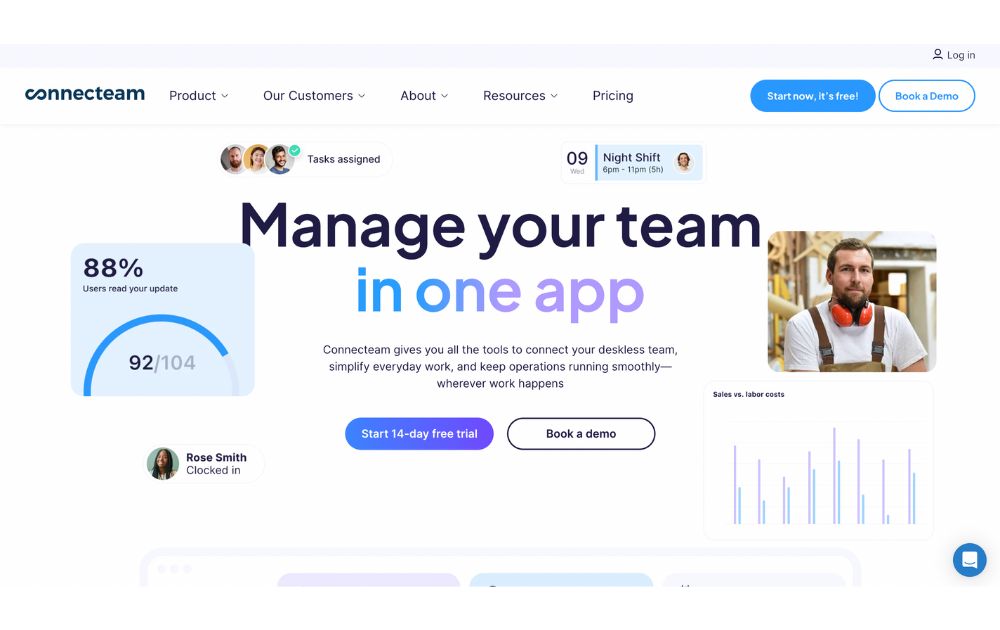
Get more people to say to work events or notify them of every single event when using Connecteam. You can chat with your teammates here. But it’s more than just that. Aside from conducting surveys and polls, you can also add a knowledge base. This serves as your office manual or handbook or a place where you can add your new memos.
Connecteam isn’t only for small businesses. Service-based businesses like cleaning, healthcare, hospitality, construction, and logistics can enjoy the features of using their platform.
Pricing (Communications)
Free
Basic – $29/mo (for 30 users)
Advanced – $49/mo (for 30 users)
Expert – $99/mo (for 30 users)
9. Basecamp

Organize your work with Basecamp since they’re a project management and employee communication tool. Get more work done with them with to-dos, chat with employees, schedule important meetings, and share files with the team.
Like Slack, you can invite clients and customers to Basecamp for smoother and seamless communication with them. There’s no need to compose an email or send a message outside Basecamp. But Basecamp has a leg up above Slack since Basecamp has privacy options you can set so clients can only see what they need to see in your workspace.
Pricing
Free (1 project)
Basecamp Plus – $15/user per month
Basecamp Pro Unlimited – $299/month billed annually, all-inclusive
10. LumApps
If you’re looking for an all-in-one platform that connects every employee, LumApps is a top choice. This employee experience platform combines internal communications, social networking, and personalized content delivery to strengthen company culture and engagement.
This tool allows HR teams as well as internal communication officers to create customized news feeds, deliver targeted announcements, and integrate with productivity apps like Google Workspace, Microsoft 365. It also has AI-powered personalization features that ensure each employee only sees content relevant to their role and interests.
Pricing: Available upon request; plans vary depending on company size and integration needs.
Featured Image Credit: Photo by Antoni Shkraba Studio from Pexels

What’s the Best Graphic Design Service for Tech Companies?

What’s the Best Graphic Design Service for Healthcare Brands?

Top 10 Free and Paid Employee Communication Tools

10 Best Photo Editing Apps for Personal and Business Use in 2026

What’s the Best Graphic Design Service for Social Media Campaign?

What’s the Best Merchandise Design Company?

Top 10 Tablets to Use in 2025

Top 10 Tablets to Use in 2025

Top 10 Free and Paid Employee Communication Tools

10 Best Photo Editing Apps for Personal and Business Use in 2026

What’s the Best Graphic Design Service for Ecommerce Businesses?

What’s the Best Graphic Design Service for Startups

What’s the Best No Limit Creatives Alternatives?

What’s the Best Merchandise Design Company?
Trending
- Technology4 days ago
Top 10 Tablets to Use in 2025
- Business24 hours ago
Top 10 Free and Paid Employee Communication Tools
- Technology1 day ago
10 Best Photo Editing Apps for Personal and Business Use in 2026
- Uncategorized4 days ago
What’s the Best Merchandise Design Company?
- Business3 days ago
What’s the Best Graphic Design Service for Social Media Campaign?
- Business21 hours ago
What’s the Best Graphic Design Service for Healthcare Brands?
- Business20 hours ago
What’s the Best Graphic Design Service for Tech Companies?

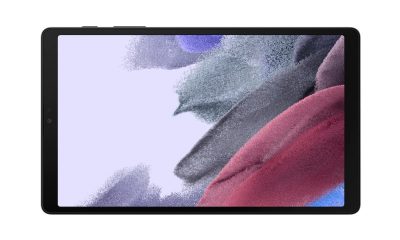






Kitesa edesa
November 4, 2023 at 1:16 pm
I have experienced so I work with you